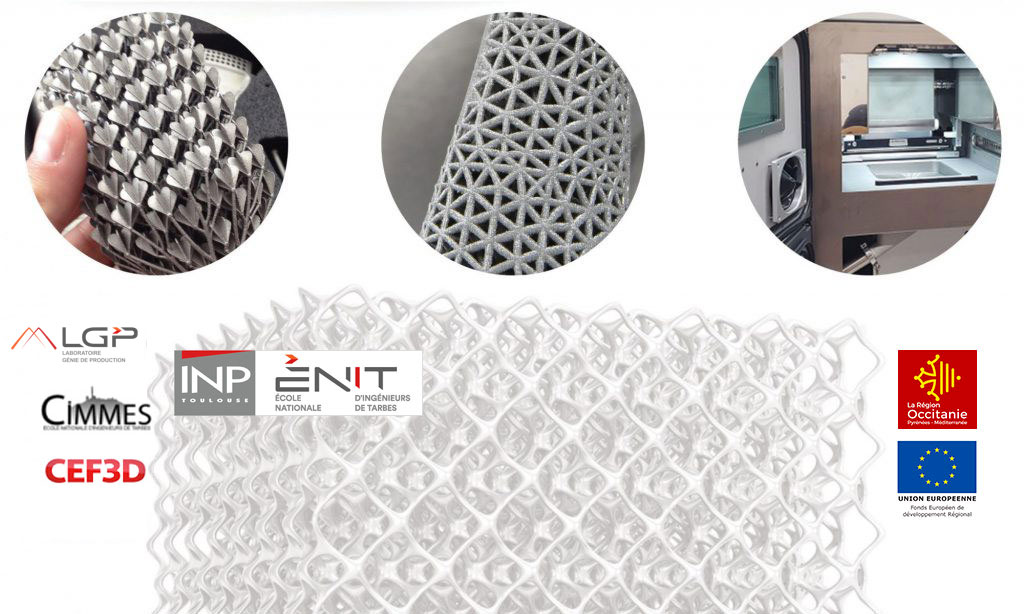- Bibliography
- Metal additive manufacturing – the essentials, Cetim, 2019 (free download).
- Introduction to Additive Manufacturing Technology, EPMA, 2018 .(download here).
- www.3Dnatives.com
- Additive Manufacturing of Titanium Alloys, 2016, B. Dutta, F. H. Froes.
- Dynamics of Lattice Materials, A. S. Phani, 2017, M. I. Hussein.
- Lased-based additive Manufacturing of Metal Parts, 2018, L. Bian, N. Shamsaei, J.M. Usher.
- Thermo-Mechanical Modeling of Additive Manufacturing, 2018, M. Gouge, P. Michaleris.
- Laser Additive Manufacturing. Materials, Design, Technologies, and Applications, 2017, M. Brandt.
- Teaching video :
Teaching at ENIT
- Master Industry 4.0 (International Master’s Degree in Computer Science)
- Advanced Additive Manufacturing (3D Metal printing)
- S1-S2 : ¿x? hours (M. Vives, M. Barrabes, F. Trey, G. Mazenc) : presentation of the ALM (mainly metallic), among the metallic processes.
- Vocabulary (standard NF EN ISO / ASTM 52900, 2017).
- General limitation of the ALM processes (dimensions of the pieces, precisions, surface states, mechanical resistance).
- Order of magnitude of costs.
- Typical manufacturing steps (STL file, positioning, orientation, support, slicing, lasing, powder removing, sanding, stress relieving, separation, polishing / machining).
- Examples of typical applications (dental, medical / implantology, space, aeronautics).
- Relevant criteria for choosing such a technology: medical application (tailor-made), high value-added parts (i.e. already very expensive at first, because very complex), functions integration (eg. replace 10 parts by one), adding new features (eg. internal cooling channels), minimal weight required.=> Expected Competencies : Use this basic information to evaluate whether a part is a priori relevant for additive manufacturing or not (i.e. selection by size (but this criterion evolves), then cost, then opportunity to add / integrate function, or significantly gain mass when it’s an important issue).
- S3 : practicals (ex. 3Dexpertise)
- S5, S6 : ?
- S7 : 4hC, GM option : industrial presentation (T. Sultan, Head of R&D – WEARETECH France)
- S8 : 6hC + 6hTD, commun courses. (L. Arnaud, F. Grizet)
- 2h: Presentation / comparison technologies (polymer and metal) and main limitations.
2h: Industrial speaker (T. Batigne, Lynxter®): technical and economic issues.
4h: Conception using Inspire® (each student chooses his subject of study, designs his piece, proposes a material-process pair, proposes optimal orientation and support for the manufacture, but also the post-treatment, specifies the quality expected and the cost ).
2h: Presentation of the problems of slicing and manufacturing.
- 2h: Presentation / comparison technologies (polymer and metal) and main limitations.
- S9 : 12hTD + 4hTP, option GM. (L. Arnaud, F. Grizet)
- 4h TD: In-depth design with Inspire®, i.e. with definition of different levels of material density (to integrate lattices), a subject freely chosen by each 1 or 2 student(s).
- 4h tutorials: CAD (Catia) with integration of lattices.
- 4h TD: F.E. modelization (Abaqus) of a piece in homogeneous bimaterials, to model the full zones and the lattices zones, with identification of the homogenized Young modules of the lattices via a 3D F.E.M. calculation on a elementary shape.
- 4h TP: production / analysis of printed parts with lattices (TP being developed in 2018).
- S9 : 2,5hC+ 3hTP : Topological optimization
- Theoretical presentation of the SIMP method
- Use of Abaqus Tosca® on an example freely chosen by the student, with methodical study on the parameters of optimization.
- S9 : advanced metal materials. (L. Lacroix, ¿x? h)
- Sx ¿ polymers ?
- S10 : practical (ex. 3D expertise)
- S10 : Practical (Master in research laboratory) (ex. Safran HE)
- S11-12-13-14-15-16 : PhD Students (ex. Cousso).
